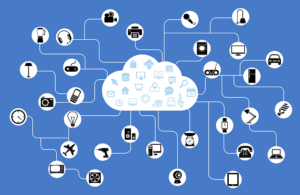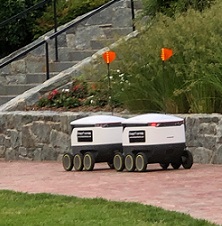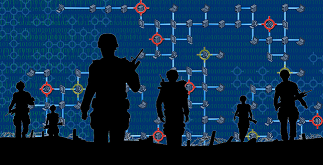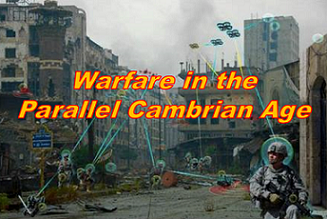[Editor’s Note: Mad Scientist Laboratory welcomes back returning guest blogger Chris O’Connor with a post that explores the exponential growth of interconnectivity via networked sensors and smart devices, resulting in ever increasingly complex and advanced battlespaces. Our ability to effectively operate in and dominate this cyberspace domain is critical in enabling Multi-Domain Operations. Soldiers must actively train for and become adept at competing in and exploiting this battlespace in order to deny our adversaries the cyber high ground — Read on!]
“Sir, the op was blown and we had to fall back to the FOB. On our way to the target location, an electric scooter began pinging its location when the point man passed it. We then began taking IDF from behind the row of houses to the east. The mortar tubes were neutralized with our LAMs. We took Route NEVADA back, which was a good thing, because we found out from EOD later that the fridge in a nearby street meat shack activated an EFP daisy chain on Route VERMONT. It would have been a cluster if we walked into that.”
****
The Evolution of “Things”
It has been said by a number of Artificial Intelligence (AI) and Machine Learning (ML) luminaries, NVIDIA’s CEO Jensen Huang among them, that we are entering a “Cambrian explosion” in that field, an era of rapid growth in neural network algorithm types and capabilities. This is a reference to the geologic period from about 542-490 million years ago, when life on Earth evolved from small, immobile ocean dwellers to an amazing diversity of species, including the first fish, our distant ancestors. Important evolutions such as predatory behaviors and eyes developed, changing the nature of life on earth.  Paleontologists don’t fully agree on what caused the biological analogue, but the AI/ML explosion has been a result of innovations in silica chips, especially GPUs (graphics processing units).
Paleontologists don’t fully agree on what caused the biological analogue, but the AI/ML explosion has been a result of innovations in silica chips, especially GPUs (graphics processing units).
This biological evolution analogy is also apt for another technological advance that will very much affect the operational environment in the near future, the Internet of Things (IoT). There is a parallel Cambrian explosion happening, here, too, where everything  around the future warfighter will go from being benign inanimate objects to sensors and communications nodes that have to be considered as vital parts of the cyber and physical terrain.
around the future warfighter will go from being benign inanimate objects to sensors and communications nodes that have to be considered as vital parts of the cyber and physical terrain.
The disruptive change here is the increasing number of ever-smaller wireless internet and cellular antennae, paired with smaller and more prolific sensors of many modalities used for domestic uses. For the sake of this article, we are going to call all of them parts of the IoT, but industry does use more discriminating terms, such as IIoT (industrial internet of things, for manufacturing machinery that  is linked via networks). Some of these “things” are blatantly obvious as smart speakers, mobile phones, and home security systems. There are plenty of other members of this family of technology that are not as capable, but still will be assets in near-future warfare.
is linked via networks). Some of these “things” are blatantly obvious as smart speakers, mobile phones, and home security systems. There are plenty of other members of this family of technology that are not as capable, but still will be assets in near-future warfare.
A massive Distributed Denial of Service (DDoS) attack in 2016 provided a preview of this threat. Over 100,000 devices were used in a botnet to attack multiple websites from IP addresses in 164 countries, simply because they had  weak or default passwords and high bandwidth internet access. These IP addresses came from DVRs, CCTV cameras, and even baby monitors. The malign actor only used these devices’ internet capabilities this time. Their embedded sensors were not used during this hack for nefarious purposes, but were de facto compromised.
weak or default passwords and high bandwidth internet access. These IP addresses came from DVRs, CCTV cameras, and even baby monitors. The malign actor only used these devices’ internet capabilities this time. Their embedded sensors were not used during this hack for nefarious purposes, but were de facto compromised.

Since then, more and more of the IoT family has come into being, and this makes this threat picture far more complex. The IoT has become an interface between the physical and cyber domains of warfare. With the advent of “connected homes,” microwave ovens are on Wi-Fi, refrigerators have cameras and screens linked to the internet, and doorbell cameras can monitor pedestrian traffic going down a street. Electric e-scooters and “park anywhere” bike rentals have GPS and wireless antennae at the least, and most sport motion and vibration sensors. Of course, there are also civilian models of drones that are very capable in skilled hands and have already been used in conflict in Syria and Yemen. Some of these items have robust built-in security features that prevent them from being hacked, especially parts of major “walled garden” software ecosystems, but that depends on user vigilance to stay secure. They are only as strong as the weakest counterfeit or unprotected node of the network.
More Eyes, Sharper Teeth
The warrior of the future will have to fight in an Operational Environment in which it will be increasingly difficult to move and communicate without detection. Networked sensor nodes are spreading in urban environments, and their concentration will only increase in the coming years. As will their capabilities;  these devices will give the adversary distributed eyes, ears, and communications, enabled by the civilian and commercial owners of the technology. Military units, security forces, or insurgent groups won’t seed the IoT in contested locations beforehand. Consumers will do that, unaware of their malign potential. Whoever is able to co-opt appliances, toys, phones, and cars to their own ends will have intelligence collection assets ready for them. The IoT is not only useful for passive reception of sensor data and information for exfiltration; it also provides the ability to communicate using grey networks. At some point in the future, our opponents will be coordinated through a smart television or receive mission update downloads through a robotic vacuum cleaner.
these devices will give the adversary distributed eyes, ears, and communications, enabled by the civilian and commercial owners of the technology. Military units, security forces, or insurgent groups won’t seed the IoT in contested locations beforehand. Consumers will do that, unaware of their malign potential. Whoever is able to co-opt appliances, toys, phones, and cars to their own ends will have intelligence collection assets ready for them. The IoT is not only useful for passive reception of sensor data and information for exfiltration; it also provides the ability to communicate using grey networks. At some point in the future, our opponents will be coordinated through a smart television or receive mission update downloads through a robotic vacuum cleaner.
The more sophisticated members of the IoT will be the myriad automated mobile systems ubiquitous to any area of human activity. Domestic robots like autonomous vacuum cleaners are the simplest example of this — they will be far smarter and have better detection capabilities in the near future. As edge computing leads to neuromorphic chips being installed in robots and other items, they will be better at making decisions about their sensor feeds without “reaching back” as often for guidance.  They will adopt roles of monitoring our health and safety with Wi-Fi signals and become more effective as lawn mowers and security guards. In 2020, there are already home security systems that control ground sensors and aerial drones. Outside domestic locations, there will be delivery robots
They will adopt roles of monitoring our health and safety with Wi-Fi signals and become more effective as lawn mowers and security guards. In 2020, there are already home security systems that control ground sensors and aerial drones. Outside domestic locations, there will be delivery robots  trundling down the street, municipal bots cleaning the sidewalks, and custodial droids waxing the floors of commercial and government buildings at all hours of the day and night. The most expensive and complex end of the automation spectrum will be trucks and cars that will have significant self-driving capability, if not the ability to drive completely without human inputs.
trundling down the street, municipal bots cleaning the sidewalks, and custodial droids waxing the floors of commercial and government buildings at all hours of the day and night. The most expensive and complex end of the automation spectrum will be trucks and cars that will have significant self-driving capability, if not the ability to drive completely without human inputs.
The potential for kinetic and deadly effects grows with each device evolution. Being attacked by an aggressive Roomba or medical assistant bot is hardly a concern of a future infantryman, but having to operate in an urban environment when the self-driving cars are trying to run you over is a much different situation.  As is being literally flushed out of concealment when the building’s plumbing system opens all of its valves, flooding the basement in which you are taking cover. The enemy doesn’t have to be anywhere near our forces in order to inflict damage, as long as there are devices they can access and control. Rural environs will not be a refuge from this technology, either. In 2020, crop fields are embedded with sensors can be used to detect passing vehicles, drones are used to monitor agriculture, tractors are self-driving, and there are wildlife cameras with motion detection. While not as densely laid out as in an urban zone, the rural IoT could act as tripwires for our forces travelling though, activating IEDs and cueing drone swarms or microsats to investigate any triggered alerts.
As is being literally flushed out of concealment when the building’s plumbing system opens all of its valves, flooding the basement in which you are taking cover. The enemy doesn’t have to be anywhere near our forces in order to inflict damage, as long as there are devices they can access and control. Rural environs will not be a refuge from this technology, either. In 2020, crop fields are embedded with sensors can be used to detect passing vehicles, drones are used to monitor agriculture, tractors are self-driving, and there are wildlife cameras with motion detection. While not as densely laid out as in an urban zone, the rural IoT could act as tripwires for our forces travelling though, activating IEDs and cueing drone swarms or microsats to investigate any triggered alerts.
Evolving for the Cambrian Age

Our forces have a few courses of action when it comes to fighting and prevailing in this age of warfare. The most direct method is shutting down power to an area of operations, but that presents several problems and does not necessarily obviate the threat. Kinetic strikes to transformers and powerplants could cause lasting damage to the infrastructure that we would want to leverage later or need for reconstruction. There is the potential for microwave weapons to offer a more precise application of this tactic, without as many long term effects to electrical systems. Regardless, it might not be successful. In urban environments, many of commercial and privately-owned electronics today have battery or generator backup. Cell phone towers will be increasingly linked to renewable power sources and distributed generators, making this tactic hard to execute. There are even plans for plug-in cars to feed back into smart grids in the event of a blackout.

Shutting down the internet is a tempting solution, but with each passing year, it will become a less effective tactic. Iran has shut down their national internet and Russia has plans to cut itself off from the rest of the world wide web, but as satellite and drone-based internet routing comes online, nations will lose control of their ability to do this. Wireless antennae can also be part of daisy chains or mesh networks, extending by miles their reach to get to broadband access. This option, along with shutting down power, could show our hand that we are in the area, which does not make it suitable to special operations, and could give the enemy indications and warnings even for maneuvers of larger formations of our Joint force — not to mention the undue suffering to civilians who happen to be in the area.
The best course of action is to leverage the IoT to our advantage, like any contested warfare domain. Instead of ceding it to our adversaries or denying it to everyone (including civilians that will be unwilling bystanders to conflict), we should use it to our advantage. Just as the enemy could use a car with intelligent systems as a sensor and comms node, we can do the same. The appliances inside houses and apartments could be used to tell us if those buildings are occupied, and depending on organic sensor capabilities, could tell us who the occupants are and if they are armed. AI/ML can be used in concert with heterogeneous sensor inputs to help us locate and identify the enemy with simple indicators. In the event that our forces are EM spectrum constrained, either self-imposed or due to an adversarial attack or jamming, we could use the grey broadband access built into domestic items. If the only way our personnel can transmit a 9-line MEDEVAC request is through a thermostat because it is the only IP address available, they should have the ability to do so.
We will have to extend our offensive cyberwarfare operations into the IoT for our forces to detect or actively attack our adversaries. DARPA is already working on hardening our wireless military networks from being hacked, but we have to penetrate into networks other than our own. This a much farther reach than the internet of battlefield things (IoBTs) that is currently being developed. Our personnel must be comfortable leveraging technology that they did not bring with them, for it will be used against them if they don’t. A large part of avoiding detection, for example, will be spoofing sensors into thinking nothing is there. New technology from the AI/ML “Cambrian age” will be an integral part of this, such as uniforms and vehicle skins that have active generative adversarial network patterns which hack sensors that detect them. Our forces will have to change almost everything they currently do if they are to prevail.

If we don’t evolve for this age, we will not be able to compete against any number of adversaries; great powers, violent extremist organizations, or even criminal gangs. We have no choice, otherwise we will be relegated to the fossil record.
****
“Ma’am, we made it past the first objective for the deep recon. We are set up in a farmhouse three clicks East of the line of control. We saw from online power usage meters where the most occupied buildings on the line were and exploited the gaps in their patrols. Their UAVs were distracted with additional motion activity from domestic drones we co-opted. As you saw, our overwatch team spoofed a security system at a building further down the line with fake video of our approach, to pull the enemy QRF away from our location. Our heavy weapons are concealed in an autodrive car that is four clicks ahead of us on a parallel route. We are moving to our next objective.”
If you enjoyed this post, check out Mr. O’Connor’s previous post, Contagion: COVID-19’s impact on the Operational Environment (Part 6) — Intentional Pandemics, as well as:
Military Implications of Smart Cities, by Alexander Braszko, Jr.
Integrated Sensors: The Critical Element in Future Complex Environment Warfare, by Dr. Richard Nabors
Nowhere to Hide: Information Exploitation and Sanitization
>>> REMINDER 1: Mad Scientist wants your Information Warfare Vignettes! We launched this crowdsourcing exercise to complement our Weaponized Information Virtual Events and we want to hear from you! Review submission guidelines on our flyer here, then craft and submit your most innovative and insightful visions of information warfare to us at: MADSCITRADOC@gmail.com. The winner of our writing contest will be present at our virtual conference on 21 July 2020. Deadline for submission is 1 July 2020!
 >>> REMINDER 2: The Mad Scientist Initiative will facilitate the fourth webinar in our Weaponized Information Virtual Events series next week, on Wednesday, 17 June 2020 (1300-1430):
>>> REMINDER 2: The Mad Scientist Initiative will facilitate the fourth webinar in our Weaponized Information Virtual Events series next week, on Wednesday, 17 June 2020 (1300-1430):
The Content Blitz: Quantifying the Islamic State’s Impact on the Saudi Twittersphere, with Henry Mihm, Inès Oulamine, and Fiona Singer, Georgetown University
Deplatforming, Deconstructed. A Typology for Technology Platforms, with Maddox Angerhofer, Kristina Cary, Bilva Chandra, and Ido Wulkan, Georgetown University
In order to participate in this virtual event, you must first register here [via a non-DoD network]. Registration is limited, so sign up now! And stay tuned to the Mad Scientist Laboratory for more information on our upcoming Weaponized Information virtual events!
>>> REMINDER 3: If you missed the first three webinars in our Mad Scientist Weaponized Information Virtual Events series — no worries! You can watch them again here.
- Chris O’Connor is a Navy Supply Corps Officer in the U.S. Navy. He has had tours at CNO Strategic Studies Group and CNO Rapid Innovation Cell and is Vice President of the Center for International Maritime Security (CIMSEC). He has written a number of fiction and non-fiction pieces on the future of warfare.
- Disclaimer: The views expressed in this blog post are those of the author, and do not necessarily reflect those of the Department of Defense, Department of the Navy, Department of the Army, Army Futures Command (AFC), or Training and Doctrine Command (TRADOC).
Additional Resources:
https://www.youtube.com/watch?v=qNtQwUO9ff8
https://www.pcworld.com/article/3135273/fridays-ddos-attack-came-from-100000-infected-devices.html
https://fortune.com/2016/11/26/tesla-stealing-hack/
https://www.sunflower-labs.com/
https://www.washingtonpost.com/politics/2019/11/27/iran-shut-down-internet-stop-protests-how-long/



